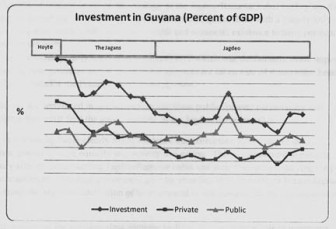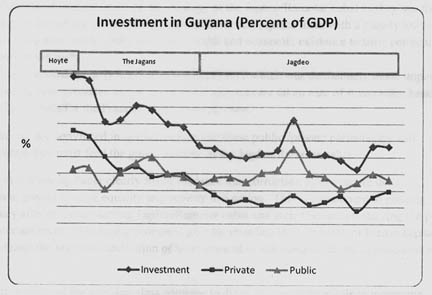Dear Editor,
Today our letter is going to expose the myth that Guyana’s economy is on a solid foundation during the current era. This is nothing but a myth and more propaganda from the ruling party which continues to distort the truth. Here are the facts.
With the Economic Recovery Programme (ERP) taking effect in 1988 under Hoyte/Greenidge it resulted in Guyana turning the corner economically. The PPP called it ‘Empty Rice Pot‘ but if it were not for the ERP, Guyana would have been the Zimbabwe of Latin America today. With a combination of the Hoyte/Greenidge public policies closely followed by those of Dr Cheddi Jagan and his able Finance Minister Dr Asgar Ally, Guyana experienced explosive investment which kicked off an average economic growth rate of 7% between 1991 and 1997. These policies fostered and encouraged private sector investments unheard of in the history of the nation. The chart below extracted from the IMF records supports this position.

The facts get quite interesting since after the departure of Janet Jagan, investment in the economy averaged 20% of GDP, save and except for the year of the great flood – 2005 when mandatory state investment had to be made on emergency repairs to the infrastructure. The situation got so bad that in 2009, Guyana had investment of 16.5% of GDP—a fact the the government has failed to recognize and instead has put out questionable figures with the intention of fooling the populace.
But what is more shocking is the fact that since 1999, the regime has been using public investment to crowd out private investment in the economy. This is an economic precedent that comes out of the playbook of the failed communist system. Private investment is usually a barometer of the confidence the private sector has in the economy and in 2009, private investment was a meagre 4% of GDP as compared to 28% of GDP during the Hoyte/Greenidge era.
As we analyze the data to understand what is happening to national investments we arrive at the following conclusions:
Under Jagdeo and now Ramotar, there has been an absence of new reforms to entice a second wave of foreign and local investors to continue the first wave unveiled during the Hoyte /Jagan era.
There is a manifestation of the ideology of those in power as they use the Treasury to crowd out the traditional private sector and replace them with a closely knit group of business buddies who owe their wealth to their political sponsors in the party.
There is weak institutional capacity, especially at GO-INVEST which was made impotent in respect of attracting new investors.
This is why we are convinced that these public /private partnerships will continue since they must feed the greed machine.
The IMF in a working paper clearly found evidence that corruption of this nature does contribute to greater income equality and poverty in a nation. This is tantamount to pouring good money after the undeserving ruling class and their friends and starving the poor. This is a certain recipe for reducing economic growth, retarding the formation of human capital and perpetuating the unequal distribution of asset ownership and ensuring unequal access to education and health.
That is why mothers of the working class continue to die at the public hospitals in increasing numbers, children who do not have access to wealth are disadvantaged in the public education system and only a few can build Taj Mahals while many still live in unsatisfactory housing like the mothers of Plastic City who live in unsanitary conditions.
We call on the Parliament to interrogate all these deals since they are based on a flawed philosophy that is designed to enrich the few with a strong political connection to the ruling class, while impoverishing the rest of the nation, especially the poor and the working class. This is clearly a development policy that does not reflect sanity.
Why does the government have to underwrite 86% of the Marriot project when the hotel occupancy rate in Guyana is only 50%? Let a thousand private investors blossom and stop this nonsense of the enrichment of a few and their political sponsors. We call on the majority opposition and the masses to challenge the PPP and stop this madness. Guyana cannot afford so much public investment in private ventures.
Yours faithfully,
Asquith Rose
Harish S Singh

